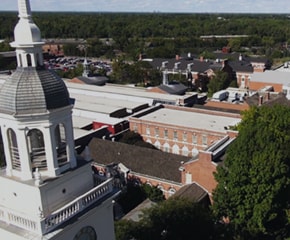
Village Industry
10 artifacts in this set
Construction of Ford Motor Company Hydro Electric Station in Saline, Michigan, 1935
Photographic print
In the early 1920s, Henry Ford began locating small hydroelectrically powered plants in rural southeast Michigan. These "Village Industries" employed local people who could maintain farms while working at the factory. One plant, constructed in Saline in the mid-1930s, operated until 1947. During World War II, workers here processed soybean oil for paints and plastics and machined parts for Pratt & Whitney engines.
Construction Progress, Ford Village Industries, Clarkston, Michigan, 1941
Photographic print
Henry Ford began setting up small-scale factories in towns throughout southeast Michigan in the 1920s. These "Village Industries" -- usually located at the site of an old mill -- employed local residents and supplied parts, tools and equipment for Ford's massive industrial operations. The factory in Clarkston, which opened in 1942, supplied Ford with seat covers, drill bushings and other material.
Ford Motor Company Gauge Plant, Northville Township, Michigan, 1936
Photographic print
In the 1920s and '30s, Henry Ford set up small-scale factories throughout southeast Michigan. These "Village Industries" supplied Ford with tools and vehicle parts. The factory at Waterford -- one of many scattered along the Middle Rouge River basin -- opened in 1925. Its employees made precision inspection gauge blocks. The plant remained open until the late 1950s.
Ford Village Industries in Saline, Michigan, 1938
Photographic print
In the early 1920s, Henry Ford began locating small hydroelectrically powered plants in rural southeast Michigan. These "Village Industries" employed local people who could maintain farms while working at the factory. One plant, constructed in Saline in the mid-1930s, operated until 1947. During World War II, workers here processed soybean oil for paints and plastics and machined parts for Pratt & Whitney engines.
Ford Village Industries Nankin Mills Plant, 1932
Photographic print
In the early 1920s, Henry Ford began locating small hydroelectrically powered plants in rural southeast Michigan. These "Village Industries" employed local people who could maintain farms while working at the factory. This Westland-area plant opened in an old flour mill in 1921. Workers here produced tool and die work and performed special engraving and defense experiment work during World War II.
Ford Village Industries Dundee Hydro Plant, 1937
Photographic print
In the early 1920s, Henry Ford began locating small hydroelectrically powered plants in rural southeast Michigan. These "Village Industries" employed local people who could maintain farms while working at the factory. This plant in Dundee operated from 1936 until 1954. During World War II, workers here manufactured parts for Pratt & Whitney engines, tanks, vehicles, and gun directors.
Ford Village Industry Plants, Southeast Michigan, 1934
Photographic print
In the 1920s and '30s, Henry Ford set up small-scale factories throughout southeast Michigan. These "Village Industries" employed local residents -- ideally farmers who could maintain their farms when not working at the factory -- and supplied Ford with tools and vehicle parts. This composite image shows several of those plants.
Hayden Mills Hydroelectric Plant, Tecumseh, Michigan, 1936
Photographic print
In the 1920s and '30s, Henry Ford set up small-scale factories throughout southeast Michigan. These "Village Industries" employed local residents -- ideally farmers who could maintain their farms when not working at the factory -- and supplied Ford with tools and vehicle parts. At Hayden Mills in Tecumseh, Michigan, employees cleaned, packed, and stored soybeans -- a crop used by Ford to make paints and plastics.
Hayden Mills Hydroelectric Plant, Tecumseh, Michigan, 1936
Photographic print
In the 1920s and '30s, Henry Ford set up small-scale factories throughout southeast Michigan. These "Village Industries" employed local residents -- ideally farmers who could maintain their farms when not working at the factory -- and supplied Ford with tools and vehicle parts. At Hayden Mills in Tecumseh, Michigan, employees cleaned, packed, and stored soybeans -- a crop used by Ford to make paints and plastics.
Map Showing Ford Motor Company Village Industries in Southeast Michigan and Ontario, Canada, 1942
Photographic print
In the 1920s and '30s, Henry Ford set up small-scale factories to supply Ford with needed tools and vehicle parts. He scattered these "Village Industries" throughout southeast Michigan usually along rivers. Ford employed local residents -- ideally farmers who could maintain their farms when not working at the factory. This map shows the factories Ford had created by 1942.
This is user-generated content and does not reflect the views of The Henry Ford.


